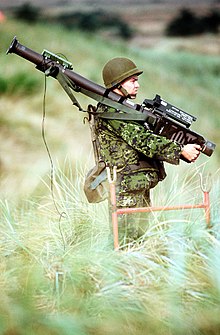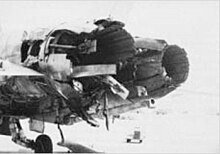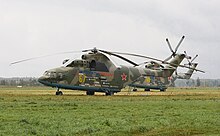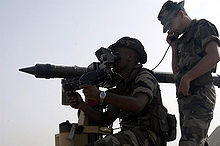Man Portable Air Defense System
A Man Portable Air Defense System ( English acronym MANPADS ; in German: Einmann-Flugabwehr-Lenkwaffe or one-man surface-to-air missile ) is a shoulder -based surface-to-air missile system . A MANPADS consists of an anti-aircraft missile and a launcher and is usually used against low-level aerial targets such as helicopters .
overview

Shoulder-mounted surface-to-air anti-aircraft missile systems (MANPADS) were developed in the late 1950s to provide protection to land forces from air raids . MANPADS can be carried and operated by a soldier. This makes it a "highly mobile system" that has been used successfully in various conflicts over the past three decades. About 20 states manufacture or produce MANPADS. Experts assume that around one million shoulder-supported air defense systems have been manufactured worldwide to date.
See also: surface-to-air missiles in asymmetric conflicts
description
MANPADS essentially consist of a launch tube in which the anti-aircraft missile is located, the launch mechanism, which is usually attached under the launch tube, and a primary battery that supplies the system with electrical energy before it is launched. The anti-aircraft missile itself consists of a rocket engine , the warhead and the flight control mechanism that controls the guided missile to its target. The rocket is hermetically sealed in the launch tube - reloading in the field is usually not possible. Unused systems can remain operational for up to 30 years if properly stored. The dimensions of typical MANPADS are between 1.2 and 2.0 meters in length. The diameter is 72 millimeters. The weight (with launch tube) ranges from 13 to 25 kilograms. Most of such systems can effectively combat airborne targets at a distance of five to eight kilometers and at an altitude of up to 5000 meters. For an experienced shooter, barely 30 seconds pass from the shoulder of the starter with the rocket to the point of firing. The majority of shoulder-mounted anti-aircraft missiles reach speeds of Mach two and have an average flight time of five to ten seconds. The guided missiles can maneuver with several g .
Countermeasures
Since most one-man anti-aircraft guided missiles are equipped with an infrared seeker head for targeting, flares are used for deception . The heat radiation that arises when using flares is intended to deflect the seeker head sensors from the actual target. However, since more modern infrared search heads can no longer be efficiently disturbed by the emission of flares, so-called Directed Infrared Counter Measures systems (DIRCM) are becoming more and more important. Here approaching missiles are exposed to spectrally adapted laser radiation, which either disrupts or damages the guided missile.
One DIRCM system specially developed for civil aviation is the Guardian missile defense system from Northrop Grumman , which has been on the market since the mid-2000s. The Guardian system is equipped with a multiband infrared laser and dazzles the infrared search heads of approaching missiles.
Many modern aircraft and helicopters are now equipped with multi-part missile warning devices that can detect approaching guided missiles. This is mostly done by locating the UV emissions of the burned rocket fuel, whereby newer systems can also record the IR radiation of the heated missile cell. In almost all cases, missile warning devices are able to trigger countermeasures fully automatically and to indicate the direction of approach to the pilot.
Types and development
Unguided

The first handgun for defense against aircraft was developed in 1944, during the Second World War , in the German Reich by the armaments company HASAG for use against low- flying aircraft . The system was named Fliegerfaust and was delivered to the Wehrmacht in the spring of 1945 . A total of only 80 pieces were produced by the end of the war. The recoil-free system consisted of nine to twelve 1.5 meter long tubes (depending on the version) with a caliber of 20 mm, which fired 90 gram bullets that detonated at a distance of about 500 meters and had an effective radius of about 60 meters in diameter. The individual rockets were launched at short intervals. They were set in rotation and thus stabilized by means of lateral bores, from which a small partial jet emerged.
Infrared
Infrared guided MANPADS are guided into the air target by means of an infrared seeker head (IR seeker head). The seeker controls the heat emissions of the engines or the metal parts of the respective air target that are heated by the exhaust gas jet. Once it has reached the heat source, the warhead ignites in the immediate vicinity of the drive unit. In this context one speaks of a passive target seeker head, since no signals or the like are emitted by the seeker head in order to detect its target. There is also no contact with the soldier who launched the missile after it has been fired. This circumstance makes defensive measures on the part of the air target more difficult, since the guided missile acts autonomously.
Infrared guided MANPADS form the largest group within shoulder-based anti-aircraft guided missiles. With the advances in electronics and computers since the 1960s, infrared guided missiles have regularly become more powerful and the hit rate has continuously increased. Accordingly, a distinction is made today between four generations of infrared-controlled MANPADS.
First generation
The first generation of infrared-guided MANPADS are so-called “tail chase weapons”, which means that the rocket pursues the target using the hot exhaust gases from the engine and its strongly heated nozzle. The seeker determines the hottest point in the sky and follows it. This fact makes IR missiles vulnerable to other heat radiating objects, such as B. the sun, or defense and disruptive measures, such as flares or the ALQ-144 system. First generation MANPADS are the US FIM-43 Redeye , the Soviet 9K32 Strela-2 (NATO code name: SA-7 Grail ) and the Chinese HN-5. The most widespread is the Strela-2 system, which was manufactured in very large numbers in the Soviet Union and other countries, partly under license. Experts suspect that tens of thousands of this system are still in circulation around the world today. With a black market price of sometimes only 5,000 US dollars, this weapon poses a serious threat to civil aviation as well.
Second generation
The second generation of MANPADS includes systems such as the American FIM-92 Stinger (referred to in Germany as Fliegerfaust 2 Stinger ), the Soviet Strela-3 (NATO code name: SA-14 Gremlin ) and the Chinese FN-6 . Each of these MANPADS is equipped with a cryogenic cooling system that can cool down the infrared seeker head considerably in a short time. This significantly increases the sensitivity, which above all leads to higher detection ranges. Furthermore, filter systems (mostly rosette scanning ) are used to better suppress natural and artificial sources of interference. In addition, the IR search heads of some systems are able to detect UV radiation in addition to infrared radiation. Since the UV signature of burned jet fuel differs significantly from burning flares or the sun, the guided weapon can better distinguish between target and interference. Second generation MANPADS are therefore largely immune to flares.
Third generation
Third-generation MANPADS, like some second-generation systems, have a seeker head that can use both infrared and UV radiation to track targets. In addition, such systems are less susceptible to hostile countermeasures in the form of flares and other natural disturbances. MANPADS third generation, for example, the French Mistral MANPADS , the Russian Igla and the US Stinger B .
Fourth generation
The fourth generation includes MANPADS, which, along with other modern sensors, are equipped with so-called focal plane array technology , similar to the AIM-9X Sidewinder air-to-air missile . The seeker head no longer consists of a detector, but of an entire field (a two-dimensional array) of infrared radiation sensors for imaging. This generation included the American FIM-92 Stinger-RMP Block II , which had a considerably increased detection range and resistance to disruptive measures. However, for cost reasons, this variant of the Stinger rocket was discontinued in the early 2000s. The first guided missile of this generation put into service is the Russian Werba . Nevertheless, experts assume that research is being carried out in this direction in Japan , France and Israel .
Command line of sight
With Command-Line-of-Sight anti-aircraft systems (CLOS), a soldier must manually direct the missile into the target missile after it has been fired, using magnifying optics and radio remote control . Since it is a semi-automatic control via line of sight, it is called the SACLOS method.
The advantage of this method is that the anti-aircraft missile is immune to flares and other countermeasures, most of which are aimed at infrared guided missiles. On the other hand, it is disadvantageous that CLOS air defense systems require a comparatively high level of training from the servicing soldiers. For example, during the Soviet Union's war in Afghanistan in the 1980s , when mujahideen were equipped with the British blowpipe MANPADS in mid-1986 . The use of this system turned out to be inefficient, as the mujahideen shooters who operated it were insufficiently trained on the system.
A newer CLOS-MANPADS is the British Javelin anti-aircraft missile system, which has been significantly modernized compared to the Blowpipe. In addition to optical daytime vision, Javelin also has a television camera.
Laser-guided
Laser -guided anti-aircraft missiles are, similar to the CLOS-MANPADS, manually guided by a soldier into the target. The target is irradiated with the laser and the rocket flies into the air target using the laser beam. Examples of this are the Swedish Robotsystem-70 - and the British Starstreak - and Starburst systems . Since there is no data exchange between the anti-aircraft missile and the “ground personnel” and the missiles do not have an infrared seeker head, effective countermeasures are not possible. Probably the biggest disadvantage for this type of target finding is, as with the CLOS method, that visual contact must be made with the target missile to be launched and therefore it is not a fire-and-forget weapon.
commitment
Probably the most devastating downing of a military aircraft by a shoulder-mounted anti-aircraft missile took place on August 19, 2002 in Chechnya . A Russian Mil Mi-26 military transport helicopter was hit by an Igla missile. The helicopter, completely overloaded with Russian military personnel, then crashed and hit a minefield. 115 people were killed.
Recently, one-man anti-aircraft guided missiles have repeatedly come into the media focus with regard to the use of terrorists against civilian machines. Due to their small size, these weapons can be easily transported and hidden. Estimates of how many MANPADS are in the hands of terrorists vary considerably, with the number being between 5,000 and 150,000. According to some experts, these are mainly infrared-guided systems that are replicas of the Soviet 9K32 Strela-2 from the 1960s.
Since the 1970s, more than 40 attacks with shoulder-mounted anti-aircraft missiles against civil aircraft have occurred worldwide. There were 28 crashes and over 800 passengers lost their lives. Most incidents occurred in conflict zones, but potential MANPADS attacks on commercial aircraft remain a real threat to the rest of the world. In June 2006, an attack with portable anti-aircraft missiles was prevented: a group of Arabs was apparently planning to use it against a transport plane operated by the Israeli airline El Al from a Swiss airport. However, this attempted attack was foiled by the Swiss security authorities. The list below shows some of these incidents in chronological order.
| date | place | Aircraft type | Airline | attacker | Victim |
|---|---|---|---|---|---|
| 1975, March 12th | Vietnam | Douglas C-54D-5-DC | Air Vietnam | Unknown | Six crew members 20 passengers |
| 1978, September 3 | Zimbabwe , Kariba | Vickers 782D | Air Rhodesia | Zimbabwe People's Revolutionary Army (ZIPRA) rebels | Four crew members 44 passengers, 10 of the 18 survivors were shot by the rebels. The remaining eight people were rescued over the next few days. |
| 1983, November 8th | Angola | Boeing 737-2M2 | TAAG Angola Airways | UNITA rebels | All inmates - 130 fatalities. According to Angolan authorities, the cause of the crash was a technical defect. UNITA rebels in the area claimed to have shot down the machine with rockets. |
| 1988, December 19 | Western Sahara | Douglas DC-7 | Chartered US Aid machine | Polisario rebels | Entire crew (five people) |
| 1993, September 21 | Georgia | Tupolev Tu-134A | Transair Georgia | Abkhazian separatists | The plane was hit by a missile and crashed into the Black Sea, killing all 27 occupants. |
| 1993, September 22 | Georgia | Tupolev Tu-154B | Transair Georgia | Abkhazian separatists | 108 of 132 inmates were killed. |
| 1994, April 6 | Rwanda | Dassault Mystère-Falcon 50 | Unknown | Unknown | All inmates were killed, including the politicians Juvénal Habyarimana and Cyprien Ntaryamira and the Rwandan chief of staff Déogratias Nsabimana . This incident is believed to have triggered the genocide in Rwanda . |
| 1998, October 10 | Congo | Boeing 727-30 | Lignes Aériennes Congolaises | Tutsi rebels | 41 fatalities |
| 1998, December 26th | Angola | Lockheed C-130 Hercules | Charter plane of the UN | UNITA rebels | 14 fatalities |
| 1999, January 2nd | Angola | Lockheed C-130 Hercules | Charter plane of the UN | UNITA rebels | Nine fatalities |
| 2002, November 28th | Kenya , Mombasa | Boeing 757-300 | Arkia Israeli Airlines | Unknown terrorists | Two Strela-2 rockets were fired, but both missed the aircraft, no casualties. |
| 2003, November 22 | Iraq | Airbus A300B4-203F | DHL cargo plane | Iraqi insurgents | The DHL Airbus was hit by a missile on the left wing, but it landed safely at Baghdad Airport, with no fatalities. |
| 2007, March 23 | Somalia , Mogadishu | Ilyushin Il-76TD | TransAVIAexport Airlines | Unknown | Shortly after the machine started, three rockets were fired, with one missile hitting the IL-76. The entire crew of eleven were killed. |
List of different models
- China
- France
- United Kingdom
- Iran
- Japan
- North Korea
- South Korea
- Pakistan
- Poland
- Romania
- Soviet Union / Russia
- Sweden
- United States
References
literature
- Simone Wisotzki: Manpads: Challenges for Arms Control and Non-Proliferation . Hessian Foundation for Peace and Conflict Research , Frankfurt / Main 2007, ISBN 978-3-937829-60-9 . ; Download as PDF (230 kB)
Web links
- Description on www.globalsecurity.org (English)
- MANPADS: Combating the Threat to Global Aviation from Man-Portable Air Defense Systems ( Memento from December 11, 2008 in the Internet Archive )
- Article about the proliferation of MANPADS and the resulting dangers on www.janes.com (English)
Individual evidence
- ↑ ( page no longer available ) Stinger one-man anti-aircraft missile at www.geschichte.luftwaffe.de ; Accessed November 23, 2008
- ↑ ( page no longer available ) Sharp rockets chase the enemy on www.luftwaffe.de ; Accessed November 23, 2008
- ↑ a b c d e f g CRS Report for Congress: Homeland Security: Protecting Airliners from Terrorist Missiles (PDF, 383 kB; English) ; Accessed November 29, 2008
- ↑ a b c MANPADS: Combating the Threat to Global Aviation from Man-Portable Air Defense Systems ( Memento of December 11, 2008 in the Internet Archive ) (English); Accessed November 29, 2008
- ↑ HASAG 'Fliegerfaust' on http://www.luftarchiv.de ; Accessed November 25, 2008
- ↑ a b c d e Shoulder Launched Missiles (AKA MANPADS): The Ominous Threat to Commercial Aviation by James C. Whitmire, Air University Maxwell Air Force Base, Alabama; (PDF, 1.36 MB; English) ; Accessed December 6, 2008
- ↑ Proliferation of MANPADS and the threat to civil aviation on www.janes.com (English); Accessed December 6, 2008
- ↑ FIM-92A Stinger Weapons System: RMP & Basic at www.fas.org (English); Accessed January 8, 2008
- ^ "Raytheon Electronic Systems FIM-92 Stinger Low-Altitude Surface-to-Air Missile System Family," Jane’s Defense , October 13, 2000
- ^ The Campaign for the Caves: The Battles for Zhawar in the Soviet-Afghan War ( Memento of November 13, 2005 in the Internet Archive ) (English); Accessed November 29, 2008
- ↑ British SAMS (English); Accessed December 6, 2008
- ↑ Russian helicopter probably shot down by rocket ; Accessed November 29, 2008
- ↑ Shot down by helicopter shocks Russia ; Accessed November 29, 2008
- ↑ a b Simone Wisotzki: Manpads: Challenges for arms control and non-proliferation . Hessian Foundation Friedens- u. Conflict research, Frankfurt / Main 2007, ISBN 978-3-937829-60-9 . P. 3.
- ↑ Aircraft accident data and report of the downing of September 3, 1978 in the Aviation Safety Network (English)
- ↑ Aircraft accident data and report of the downing of November 8, 1983 in the Aviation Safety Network (English)
- ↑ Aircraft accident data and report of the shooting down on September 21, 1993 in the Aviation Safety Network (English)
- ↑ Aircraft accident data and report of the shooting down on September 22, 1993 in the Aviation Safety Network (English)
- ↑ Aircraft accident data and report of the shooting down on March 23, 2007 in the Aviation Safety Network (English)









